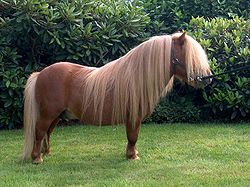 Shetland Ponies are hardy and strong, in part because the breed developed in the harsh conditions of the Shetland Isles. In appearance, Shetlands have a small head, sometimes with a dished face, widely-spaced eyes and small and alert ears. The original breed has a short, muscular neck, compact, stocky bodies, and short, strong legs and a shorter than normal cannon bone in relation to their size. A short broad back and deep girth are universal characteristics as is a springy stride. Shetlands have long thick manes and tails and a dense double winter coat to withstand harsh weather. Different breed registries have different height standards, but the outside ranges are between a minimum of 7 hands and 11.2 hands (28 to 46 inches (71 to 117 cm)).
Shetland Ponies are hardy and strong, in part because the breed developed in the harsh conditions of the Shetland Isles. In appearance, Shetlands have a small head, sometimes with a dished face, widely-spaced eyes and small and alert ears. The original breed has a short, muscular neck, compact, stocky bodies, and short, strong legs and a shorter than normal cannon bone in relation to their size. A short broad back and deep girth are universal characteristics as is a springy stride. Shetlands have long thick manes and tails and a dense double winter coat to withstand harsh weather. Different breed registries have different height standards, but the outside ranges are between a minimum of 7 hands and 11.2 hands (28 to 46 inches (71 to 117 cm)).
Shetlands can be almost every colour, including skewbald and piebald (called pinto in the United States), but are mainly black, chestnut, bay, brown, gray, palomino, dun, roan, cremello, and silver dapple. Registered shetlands are not leopard spotted (Appaloosa), nor do they carry the champagne gene, though these colors are sometimes seen in Shetland-sized crossbreds.
Shetland ponies are generally gentle, good-tempered, and very intelligent by nature. They make good children's ponies, and are sometimes noted for having a "brave" character, but can be very opinionated or "cheeky", and, if not handled properly, can be impatient, snappy, and sometimes become uncooperative, traits often lumped under the label "stubborn" by those who fail to understand that pony behavior is influenced by the quality of human handling. Due in part to their intelligence and size, they are easily spoiled and can be very headstrong if not well-trained.
For its size, the Shetland is the strongest of all horse and pony breeds. It can pull twice its own weight under circumstances where a draft horse can only pull approximately half its own weight, as well as many being able to carry up to 9 stone – 130 pounds (59 kg). Shetland ponies are found worldwide, though mainly in the UK and North America. In general, UK ponies tend to preserve more of the original characteristics of the breed and are often stockier than their American cousins.
Many ponies are long-lived, it is not unusual for a Shetland pony to live more than 30 years. Conversely, their small size also predisposes some individuals to a greater probability of heart problems than in larger animals, on occasion leading to early death. Shetland ponies, like many hardy small horse and pony breeds, can easily develop laminitis if on a diet high in non-structural carbohydrates. Therefore owners must pay careful attention to nutrition, being careful to regulate feed quantity and type.
